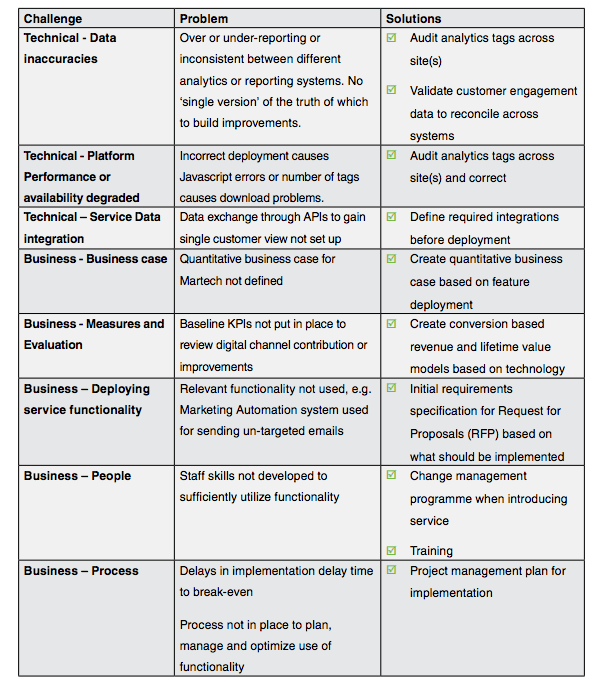How to build the right marketing technology stack for your business
It's now a lot more common to talk about choosing 'martech stacks' and rightly so, given the impact that technology, data and insight can have on marketing today. The popularity of the concept of a martech stack has grown out of the categorisation of marketing technology based on Scott Brinker’s Martech landscape and others such as our Digital Tools wheel.
Businesses have always considered their portfolio of business IT applications for operations such as finance, logistics and marketing, but traditionally, they have been controlled by IT teams who have managed a limited number of ‘enterprise resource planning’ systems such as SAP. With the growth in cloud based SaaS, it has become far easier for individual departments and, in particular, marketing, who need to manage many digital marketing channels like search and social media marketing, to deploy their own solutions.
What is it? Martech stack
A marketing technology stack is the combination of different software services or tools used to run all marketing operations including customer acquisition, conversion, retention, team communications and to deliver customer and market? insight and reporting.
As businesses have deployed more martech services, the need to manage and integrate them has been highlighted. Many companies simply select individual marketing technologies to meet immediate operational needs of managing their marketing. This can quickly lead to a proliferation of tech within a company which gives these potential ‘Martech sins’, almost all giving rise to a lack of integration. Potential, common problems include:
1. No long-term plan for martech.
A haphazard approach of implementing different tools for different functions known as ‘Random Acts of Technology’, RAT.
2. Insufficient rigour when evaluating martech.
To select the most suitable technology requires the time for a structured review by someone who is experienced in IT or software selection and business case development. If the time or skills aren’t available for this, then the strength of the vendors claims may sway the decision without sufficient trial of solutions on operational processes.
3. Technology solutions from different vendors aren’t integrated.
With multiple tools, data silos can develop where you can’t extract or combine data from different applications without manual export processes.
4. Data is inconsistent.
A single customer view or ‘360 degree view of the customer’ is an aspiration for most businesses, but the reality is often that data in different analysis systems will report different values, so there is no ‘single version of the truth’. 1 Luma Partners: Lumascapes covering digital marketing and advertising technology. Marketing Technology Selection Guide.
5. Customer journeys can’t be tracked across channels.
Customer journeys are now more complex than every before with a proliferation of digital marketing channels adding to traditional offline channels that remain important for most businesses. Then there are cross-device journeys as customer consume content on mobile and desktop devices. þ 6. New Martech isn’t rolled-out with sufficient updates to training and process. While the appeal of cloud-based SaaS is that they can often be installed by simply tagging the site with relevant javascript, the reality is that far more is involved. Consider Google Analytics. In our experience, many have it running on their site, yet have not customized it, run training or the changes to review and reporting processes needed to get the most from it.
6. Return on Marketing Technology isn’t reviewed.
We have mentioned that the business case for adoption isn’t sufficiently defined. The other side of this is that, the loop isn’t closed, so that post adoption, the effectiveness of martech in improving marketing operations and results isn’t considered. Often there are errors in deployment which can lead to inaccuracies in data quality which can hinder the performance of marketing.
7. Service performance or availability issues.
With any type of software, you are reliant on the quality shown by bugs from the developers which may cause it to fail. These issues also apply to cloud-based services, although they have the benefit that errors can potentially be removed and an updated patched to all users more rapidly than more traditional software where it needs to be installed. With cloud service, there are also challenges with server failure. Even the tech giants like Google and Facebook have suffered outages of hours. A smaller provider could potentially be offline for even longer.
The table below provides a more structured way of looking at these challenges with a suggestion of how these problems can be minimised.

To avoid these problems and others, all businesses should think through the best structure and components for their martech stack, even smaller businesses. The answer to ‘Why’ according to Penni Pickering, Marketing Manager at Gold-Vision CRM, writing for Smart Insights is: “Because you already have one!” She explains that without realising it, almost every business, no matter how small, will have some form of marketing technology stack. And it will naturally grow with your business. She says:
“If you don’t plan now, you are likely to end up with a tangle of disparate systems all churning out data – none of which you can combine and measure.you have a customer database, combined with a website and send emails you already have a stack. Add social platforms, analytics, a CMS, Display and Re-targeting ads, and a Marketing Automation platform and suddenly that is a LOT of technology and a lot of data”.
So avoid those martech sins and start planning you stack better.








